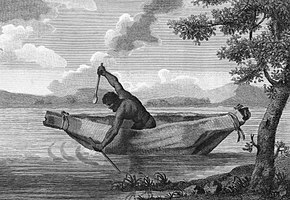Cleverman
Some sources also refer to clevermen having the ability to kill using magic, although this may be illegal within the culture or a separate form of harmful 'sorcery' from that used by cleverman healers.
They have a strong understanding of sacred places and lore (which includes cultural heritage, laws, spiritual beliefs, behaviours, and rituals) and a deep connection to the Dreaming.
[2] Older clevermen choose a younger community member to take their place as a cleverman, teach them the necessary skills over many years, and conduct initiation ceremonies which are often kept secret.
[6] Other clevermen communicate with spirits such as the mimih, who long ago taught the marrkidjbu of the Bininj Kunwok people the ritualistic steps of carving up a kangaroo.
[7] Some ceremonies, including those of the Wiradjuri people, involve communication with spiritual beings, the granting of supernatural abilities, and absorbing magical objects into the body.
[2] The healing practices of clevermen have seen particular interest from outside of their communities by researchers looking for more effective methods of treating Aboriginal peoples' mental and physical health.
[2] For example, Ngangkari healers have seen broad acceptance for their abilities and frequently work with hospitals to heal Aboriginal patients.
These practices have parallels in many cultures world-wide and their effects have been referred to as "voodoo death" or "nocebo" by scholars.

